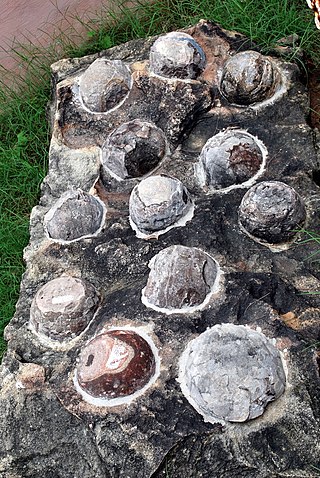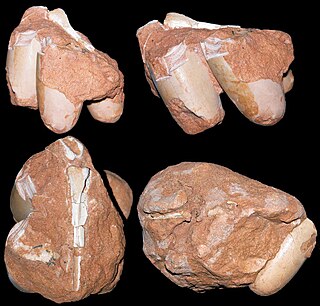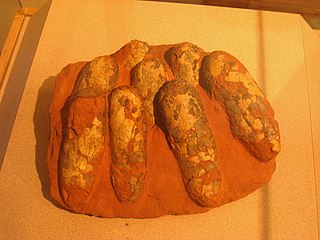
Dinosaur eggs are the organic vessels in which a dinosaur embryo develops. When the first scientifically documented remains of non-avian dinosaurs were being described in England during the 1820s, it was presumed that dinosaurs had laid eggs because they were reptiles. In 1859, the first scientifically documented dinosaur egg fossils were discovered in France by Jean-Jacques Poech, although they were mistaken for giant bird eggs.

The Blesa Formation is a geological formation in Teruel and La Rioja, Spain whose strata date back to the Barremian of the Early Cretaceous. Dinosaur remains as well as eggs are among the fossils that have been recovered from the formation. Along with the fragmentary anhanguerian pterosaur Iberodactylus. While the lower and upper parts of the formation were deposited in a continental setting, the middle portion of the formation is largely nearshore marine, with remains of plesiosaurs.

Cairanoolithus is an oogenus of dinosaur egg which is found in Southwestern Europe. The eggs are large and spherical. Their outer surface is either smooth, or covered with a subdued pattern of ridges interspersed with pits and grooves. Multiple fossil egg clutches are known but the nest structure is unclear.
Shixingoolithus is an oogenus of dinosaur egg from the Cretaceous of Nanxiong, China.
Protoceratopsidovum is an oogenus of dinosaur egg from Mongolia. Despite its name, it does not represent the eggs of a protoceratopsid, but rather the eggs of maniraptoran theropods.

Macroolithus is an oogenus of dinosaur egg belonging to the oofamily Elongatoolithidae. The type oospecies, M. rugustus, was originally described under the now-defunct oogenus name Oolithes. Three other oospecies are known: M. yaotunensis, M. mutabilis, and M. lashuyuanensis. They are relatively large, elongated eggs with a two-layered eggshell. Their nests consist of large, concentric rings of paired eggs. There is evidence of blue-green pigmentation in its shell, which may have helped camouflage the nests.
Continuoolithus is an oogenus of dinosaur egg found in the late Cretaceous of North America. It is most commonly known from the late Campanian of Alberta and Montana, but specimens have also been found dating to the older Santonian and the younger Maastrichtian. It was laid by an unknown type of theropod. These small eggs are similar to the eggs of oviraptorid dinosaurs, but have a distinctive type of ornamentation.
Ageroolithus is an oogenus of dinosaur egg. It may have been laid by a theropod.
Dispersituberoolithus is an oogenus of fossil egg, which may have been laid by a bird or non-avian theropod.

Egg fossils are the fossilized remains of eggs laid by ancient animals. As evidence of the physiological processes of an animal, egg fossils are considered a type of trace fossil. Under rare circumstances a fossil egg may preserve the remains of the once-developing embryo inside, in which case it also contains body fossils. A wide variety of different animal groups laid eggs that are now preserved in the fossil record beginning in the Paleozoic. Examples include invertebrates like ammonoids as well as vertebrates like fishes, possible amphibians, and reptiles. The latter group includes the many dinosaur eggs that have been recovered from Mesozoic strata. Since the organism responsible for laying any given egg fossil is frequently unknown, scientists classify eggs using a parallel system of taxonomy separate from but modeled after the Linnaean system. This "parataxonomy" is called veterovata.
Sankofa is an oogenus of prismatoolithid egg. They are fairly small, smooth-shelled, and asymmetrical. Sankofa may represent the fossilized eggs of a transitional species between non-avian theropods and birds.
Prismatoolithidae is an oofamily of fossil eggs. They may have been laid by ornithopods or theropods.

Styloolithus is an oogenus of highly distinctive fossil egg from the Upper Cretaceous Djadokhta Formation and the Barun Goyot Formation in Mongolia.

Elongatoolithidae is an oofamily of fossil eggs, representing the eggs of oviraptorosaurs. They are known for their highly elongated shape. Elongatoolithids have been found in Europe, Asia, and both North and South America.
Mycomorphoolithus is an oogenus of fossil eggs found in Spain and England. They possibly represent eggshells of non-eusuchian crocodylomorphs, and are similar to, but not part of, the Krokolithidae.
Guegoolithus is an oogenus of fossil egg from the early Cretaceous of Spain. It is classified in the oofamily Spheroolithidae, and was probably laid by an ornithopod dinosaur.
Dictyoolithidae is an oofamily of dinosaur eggs which have a distinctive reticulate organization of their eggshell units. They are so far known only from Cretaceous formations in China.

Gobioolithus is an oogenus of fossil bird egg native to Mongolia. They are small, smooth-shelled, and elongated eggs that were first discovered in the 1960s and early 70s during a series of fossil-hunting expeditions in the Gobi desert. Two oospecies have been described: Gobioolithus minor and G. major. The eggs were probably laid in colonial nesting sites on the banks of rivers and lakes.
Pachycorioolithus is an oogenus of small, thin-shelled fossil egg from the early Cretaceous in China. It probably belongs to a bird, though there is a possibility the parent was a non-avian theropod. It was named in 2016, based on a single specimen found in Zhejiang.
Plagioolithus is an oogenus of fossil egg. It is from the Early Cretaceous of Japan. It was probably laid by a bird, making it the oldest known fossil bird egg.






